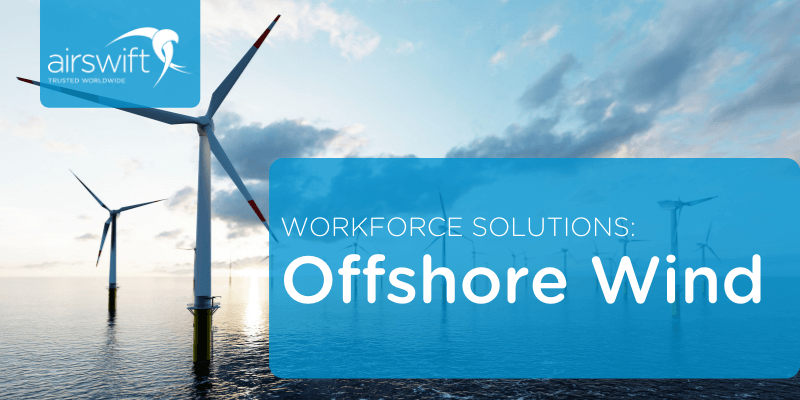
224
Offshore wind jobs filled globally
Staffing, HR and employment services


EMPLOYER SERVICES
Our contract and direct hire recruiters help top talent at every stage of their job search. Whether you’re searching for full-time or temporary work, Airswift can help you find the right role for your career goals and skill set.

224
Offshore wind jobs filled globally

17
Countries where we have hired

26
Different disciplines we recruit for
The global wind market is set for exponential growth over the next few years. The industry is changing, and we understand the challenges facing the sector.
Airswift has proven experience in supporting TSOs, developers and contractors for numerous offshore wind jobs and projects throughout the world.
We have successfully placed both permanent and contract personnel across a wide range of wind energy disciplines. These include engineering, QHSE, project controls and SCM, geotechnical and project management.
Our dedicated team of consultants are able to support clients throughout the whole project lifecycle. This includes the areas of cable engineering, offshore installation, fabrication and inspection, commissioning and O&M.

A major renewable energy client in Rhode Island needed a Client Representative for offshore wind installation, requiring GWO Basic Safety Training, OGUK medical clearance, and strong communication skills. The ideal candidate had experience monitoring site activities, reviewing risk assessments, and preparing daily reports.
Airswift sourced a candidate with extensive offshore wind expertise and a strong commitment to safety. They ensured compliance with procedures, participated in safety walks, and maintained quality standards. Their technical proficiency and proactive approach improved on-site oversight, reduced project risk, and supported the timely delivery of key milestones.

Our client urgently needed a Project Engineer for cable system supply on the Princess Elisabeth Island project, requiring offshore HVDC cable experience, technical expertise, and strong communication skills for the tendering and design phase.
We headhunted a candidate with a Master’s in Electrical Engineering, over five years of EPC cable project experience, and knowledge of ampacity calculation and international standards. They played a key role in bid evaluation, technical negotiations, and design review, ensuring high-quality deliverables. Their proactive management and focus on safety and design solutions helped progress the project efficiently and mitigate risk in the offshore environment.

Provider of contract hire, mobilisation, payroll and employment services to a floating offshore wind farm in Europe.

Airswift provided qualified candidates across a wide range of disciplines for an Offshore Wind project in the Netherlands and Germany

Airswift helped 8 Rivers scale their workforce by 31% in two years.

Airswift successfully identified and placed a number of personnel to the project in the following roles and continue to support Vestas on this and a number of other projects worldwide.

Airswift’s global offices present a key advantage to our clients.
With over 60 strategic, global offices we are equipped to assist clients, deliver on key projects, in the renewable energy industry.
Our in-country teams are available to provide key workforce solutions for renewables projects across the globe.

Worley
Client

FieldCore
Client

Siemens Gamesa
Client

Bourbon
Client

Find your next role
Our contract and direct hire recruiters help top talent at every stage of their job search. Whether you’re searching for full-time or temporary work, Airswift can help you find the right role for your career goals and skill set.
Contract
19 Dec 2025
Houston, Texas, United States
Quality Assurance Specialist IV
Our client, a major Oil & Gas company, is looking for a Quality Assurance ...
Contract
17 Dec 2025
Constanta, Romania
Location: South East, Romania Start Date: April 2026 Duration: 18+ months Key ...
Contract
17 Dec 2025
Constanta, Romania
Onsite Civil QA Specialist: We are seeking a Civil QA (Quality Assurance) ...
Contract
17 Dec 2025
Constanta, Romania
Job Title: Construction Manager – Onshore Wind Project Location: Constanta, ...
Contract
17 Dec 2025
Clywd, United Kingdom
Role: Site SHEQ Engineer (HSE Engineer / HSE Advisor) Contract Type: Freelance ...
Contract
17 Dec 2025
Edinburgh, United Kingdom
We are seeking a Project Manager to support a leader in the subsea cables ...
Contract
9 Dec 2025
Permanent
28 Nov 2025
Permanent
19 Nov 2025
Seoul, Korea; Republic Of (South)
Senior Stakeholder Manager will play a crucial role in developing and ...

GETI is an annual energy employment trends report focused on oil and gas, renewables, power, nuclear and petrochemicals.

Discover 10 major renewable energy projects in Australia, including wind, solar and battery storage, and the job opportunities shaping the clean energy sector.

Explore 5 wind farm projects in Australia creating jobs in the wind energy industry, plus market trends and workforce forecasts shaping the sector.

Explore top U.S. wind energy projects launching from 2026, with insights on renewable trends, onshore vs offshore growth, and policy impacts on clean power.

Investment in wind energy projects is growing, especially in Asia. This blog outlines the top 10 Asian offshore wind farm projects and skills in demand.